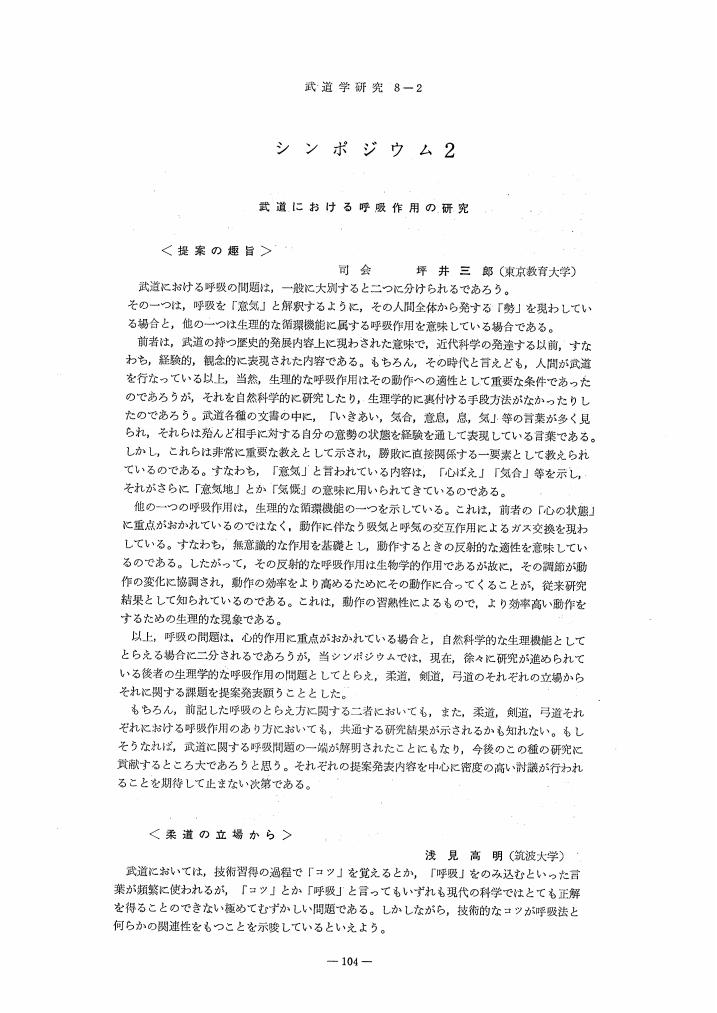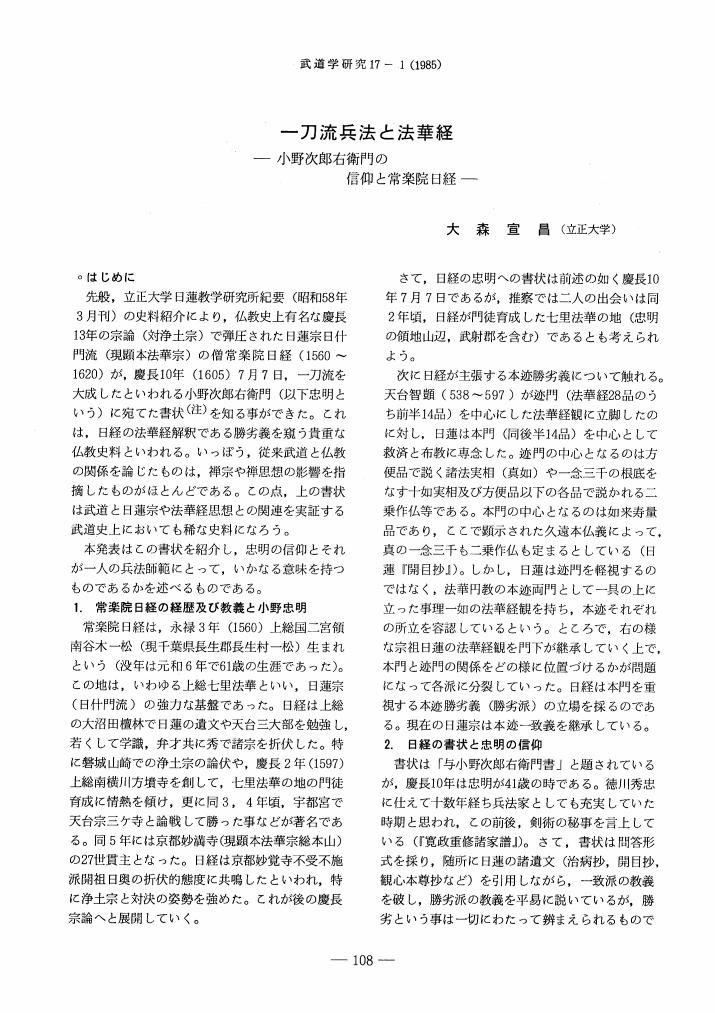2 0 0 0 OA 柔道競技における「判定」と「ゴールデンスコア」の比較に関する研究
- 著者
- 菅波 盛雄 斉藤 仁 廣瀬 伸良 中村 充 林 弘典 増地 克之
- 出版者
- 日本武道学会
- 雑誌
- 武道学研究 (ISSN:02879700)
- 巻号頁・発行日
- vol.38, no.1, pp.1-12, 2005-07-31 (Released:2012-11-27)
- 参考文献数
- 20
IJFは2001年までは「判定方式」,2002年からは「ゴールデンスコア方式」を採用している。本研究は,2000年から2003年までの4年間に国際柔道連盟が主催した4大会を対象として,試合終了時に両試合者のスコアが同一であった試合の分析を試みた。2000年世界Jrナブール大会と2001年世界選手権ミュンヘン大会,全1,356試合の中で「判定」によって勝敗が決したのは73試合(5,4%)であった。2001年世界Jr済州島大会と2003年世界選手権大阪大会,全1,285試合の中で「GS」によって勝敗が決したのは42試合(3.3%)であり減少がみられた。「判定」によって勝敗が決した73試合を施技ランクB,Cおよび組み手主導権の3項目で比較した結果,審判員の判定が3対0の時にプラスポイントが確認された選手が勝ちとなったのは73,8%であった。一方,2対1の時はプラスポイントでの勝ちが41.9%と減少がみられたことから,全員一致の判定の困難さが窺える。同様の手法で「GS」に入る前の試合分析から,「GS」への移行が妥当と判断されたのは11試合(26.2%)であり,残りの31試合(73.8%)は項目比較によって優劣に差がみられた。「GS」導入によって試合時間は「判定方式」に比べて長くなるが,「判定」に対する「GS」の試合時間比は4分の試合で1.43倍増に対して,5分では1.28倍と減少が認められた。「GS方式」の導入によって,試合終了時に同一スコアとなる試合が激減した。また,実質上の試合時間を抑制する傾向が窺え,延長時間の問題も許容範囲であると言える。「GS」による試合は,罰則よりもポイント取得によって勝敗が決する方向にあり,勝負判定の客観化を推進するためには有効な改正であった。
2 0 0 0 直心影流の成立とその伝系及び伝承に関する一考察
- 著者
- 軽米 克尊 酒井 利信
- 出版者
- 日本武道学会
- 雑誌
- 武道学研究 (ISSN:02879700)
- 巻号頁・発行日
- vol.47, no.3, pp.119-138, 2015
The aim of this study is to clarify as much as possible the process of formation of the Jikishinkage-ryū, and by comparing that to the lineage and transmission from after its formation, to show how it has changed. Specifically, we verified whether the lineage and transmission mentioned in the scrolls written after the Jikishinkage-ryū's formation agree with those in the formation process. First, we examined the lineage and transmission in the scrolls written after the formation of Jikishinkage-ryū, and analyzed the formation process to clarify rewritten points in its lineage. We clarified the following six points:<BR>1.Yamada Heizaemon Mitsunori referred to himself as the second generation head of Jikishinseitō-ryū, not Jikishinkage-ryū. Therefore, it is after Naganuma Shirōzaemon Kunisato that Jikishinseitō-ryū was renamed Jikishinkage-ryū. This means there is a discrepancy between the period of the Jikishinkage-ryū's formation and its transmission.<BR>2.Multiple discrepancies regarding names and meanings can be spotted between historical materials written by the people mentioned in the lineage of Jikishinkage-ryū, and the transmission mentioned in the scrolls written after Jikishinkage-ryū was formed. This indicates that parts of the transmission were rewritten after the formation of Jikishinkage-ryū.<BR>3.It is in the "Jikishinkage-ryū Mokuroku Kudensh" (Catalogue of techniques and oral transmission of Jikishinkage-ry) by Naganuma Shirōzaemon Kunisato that Matsumoto Bizen-no-Kami was first recognized as the founder of Jikishinkage-ryū.<BR>4.The Enpi kata of Shinkage-ryū that originates from Kage-ryū can also be confirmed in the catalogue of techniques of Shinshinkage-ryū, although written with different kanji. Therefore, Shinshinkage-ryū can be said to have been affected by Kage-ryū via Shinkage-ryū.<BR>5.The name and meaning of each school (ryū) found in the lineage of Jikishinkage-ryū were interpreted with the consideration that the tradition bestowed by the deity of martial arts was inherited from generation to generation. This was from Matsumoto Bizen-no-Kami, the founder, to Yamada Heizaemon Mitsunori, who changed the name of the school to Jikishinkage-ryū.<BR>6.It is after Naganuma Shirōzaemon Kunisato that the colophon "Kashima Shinden," which shows that the style was bestowed by the deity Takemikazuchi, started to be used. It is also after Kunisato that Takemikazuchi was recognized as the originator of the school.
2 0 0 0 剣道の打突時における「踏み込み足」の指導についての考察
- 著者
- 滝沢 光三
- 出版者
- 日本武道学会
- 雑誌
- 武道学研究 (ISSN:02879700)
- 巻号頁・発行日
- vol.14, no.2, pp.104-105, 1982
2 0 0 0 OA 澁川一流柔術
- 著者
- 森本 邦生
- 出版者
- 日本武道学会
- 雑誌
- 武道学研究 (ISSN:02879700)
- 巻号頁・発行日
- vol.47, no.3, pp.139-146, 2015-03-31 (Released:2016-03-31)
2 0 0 0 OA 日本剣道形の由来と解釈: 大日本帝国剣道形の草案・原案・成文の比較対照
- 著者
- 大矢 稔
- 出版者
- 日本武道学会
- 雑誌
- 武道学研究 (ISSN:02879700)
- 巻号頁・発行日
- vol.35, no.1, pp.35-52, 2002-07-31 (Released:2012-11-27)
- 参考文献数
- 31
The compilation of the Dainihonteikoku Kendo-Kata has undergone 3 stages of “Sketch-Draft-Codification. ” In this paper, the original texts of these stages are compared and scrutinized concerning when, what and how amendments were added, and furthermore tendencies in the nature of the amendments were discussed, as well as its implications.In the evolution from the sketch to the draft, it seems the chief investigators and the investigators had question-and-answer sessions and exchanged views, and then, based on the results the chief investigators, re-examined the sketch to make amendments.For the purpose of organizing a unified Teikoku-Kendo-Kata transcending schools, organizing work is thought to have been encouraged by placing special emphasis on the basic concept, overall picture and comprehensive constitution of the Teikoku-Kendo-Kata. In addition, because it was governed by the chief investigators' mastery of the art of kendo, theory on techniques, and profound perception of the Teikoku-Kendo-Kata, the details of the sketch were not regarded as matters of particular importance. Consequently, in the work from the sketch to the draft, the Kodachi-Kata was settled on as not to be amended, and a total of 17 items, including 2 of the basic,5 of Tachiai and 10 of Tachi-Kata, as items to be amended.From the draft to the codification, through the deliberations of the Teikoku-Kendo-Kata Investigation Committee,6 amendments were adopted at first. Afterwards, as a result of the chief investigators' and the investigators' practicing the Teikoku-Kendo-Kata, minor differences became regarded as problems and amendments were added owing to the necessity of having more precise explanation for the sake of instruction. Finally, in the process of progression from the draft to codification, amendments were added for the first time to the Kodachi-Kata, and a total of 27 amendment items, containing 4 of the basic,4 of Tachiai,12 of Tachi-Kata and 7 of Kodachi-Kata items plus 6 items by the Teikoku-Kendo-Kata Investigation Committee's decisions, were added before release of the codification by the management office of the Butoku-Kai.
2 0 0 0 OA 弓道情報理論に関する基礎的研究
- 著者
- 山田 奨治
- 出版者
- 日本武道学会
- 雑誌
- 武道学研究 (ISSN:02879700)
- 巻号頁・発行日
- vol.20, no.2, pp.157-158, 1987-11-30 (Released:2012-11-27)
2 0 0 0 OA 弓道における的中記録の電算化とその利用
2 0 0 0 OA 剣道面打撃時の竹刀にかかる力についての研究
- 著者
- 山口 幸一 神崎 浩
- 出版者
- 日本武道学会
- 雑誌
- 武道学研究 (ISSN:02879700)
- 巻号頁・発行日
- vol.44, no.Supplement, pp.S_27-S_27, 2011 (Released:2012-08-31)
2 0 0 0 OA 剣道の打突が人体(頭部)に及ぼす影響について-その2-
2 0 0 0 OA 空手道・弓道専門分科会合同シンポジウム「中学校武道必修化について」
- 出版者
- 日本武道学会
- 雑誌
- 武道学研究 (ISSN:02879700)
- 巻号頁・発行日
- vol.41, no.3, pp.59-60, 2009-03-31 (Released:2012-11-27)
2 0 0 0 OA 弓道における「離」の研究
2 0 0 0 OA 武道の捉え方 —世界の動向—
- 著者
- 百鬼 史訓 金 正幸 W. J. シナルスキー 大保木 輝雄 アレキサンダー・ ベネット
- 出版者
- 日本武道学会
- 雑誌
- 武道学研究 (ISSN:02879700)
- 巻号頁・発行日
- vol.45, no.3, pp.213-241, 2013-03-29 (Released:2014-04-04)
- 参考文献数
- 41
2 0 0 0 OA 武道における呼吸作用の研究
- 出版者
- 日本武道学会
- 雑誌
- 武道学研究 (ISSN:02879700)
- 巻号頁・発行日
- vol.8, no.2, pp.104-107, 1976-01-30 (Released:2012-11-27)
2 0 0 0 OA 近世後期水戸藩における剣術の様相について―杉山復堂『公覧始末』をめぐって―
- 著者
- 長尾 進
- 出版者
- 日本武道学会
- 雑誌
- 武道学研究 (ISSN:02879700)
- 巻号頁・発行日
- vol.28, no.Supplement, pp.70-70, 1995 (Released:2012-11-27)
2 0 0 0 OA 一刀流兵法と法華経―小野次郎右衛門の信仰と常楽院日経―
- 著者
- 大森 宣昌
- 出版者
- 日本武道学会
- 雑誌
- 武道学研究 (ISSN:02879700)
- 巻号頁・発行日
- vol.17, no.1, pp.108-109, 1985-01-30 (Released:2012-11-27)
2 0 0 0 OA 学校剣道からみた剣道野試合の価値に関する研究―岡崎市第8回剣道野試合大会を中心に―
- 著者
- 中林 秀治
- 出版者
- 日本武道学会
- 雑誌
- 武道学研究 (ISSN:02879700)
- 巻号頁・発行日
- vol.1, no.1, pp.53-53, 1968-12-25 (Released:2012-11-27)
2 0 0 0 OA 剣道技術の目的の変遷に関する研究―一刀流兵法とその展開―
- 著者
- 吉谷 修
- 出版者
- 日本武道学会
- 雑誌
- 武道学研究 (ISSN:02879700)
- 巻号頁・発行日
- vol.16, no.1, pp.1-2, 1984-01-31 (Released:2012-11-27)
- 参考文献数
- 6
2 0 0 0 OA 小野家伝書に見る“切落し”の仕様―特に,組太刀全体における位置づけ―
- 著者
- 吉田 鞆男
- 出版者
- 日本武道学会
- 雑誌
- 武道学研究 (ISSN:02879700)
- 巻号頁・発行日
- vol.25, no.Supplement, pp.28-28, 1992 (Released:2012-11-27)
2 0 0 0 OA 直心流柔術の系譜検証:『直心流柔序』の読解を通して
- 著者
- 中嶋 哲也
- 出版者
- 日本武道学会
- 雑誌
- 武道学研究 (ISSN:02879700)
- 巻号頁・発行日
- vol.43, no.1, pp.1_9-1_17, 2010-08-31 (Released:2012-08-28)
- 参考文献数
- 24
直心流柔術の系譜に関する主な研究として 1990年に発表された論文,「直信流柔道について 一流名・術技及びその思想一」(以下,当該論文と表記)をあげることができる。当該論文では『直心流柔序』という伝書を使用し,直心流柔術から直信流柔道へ至る系譜について明らかにしようとしている。しかしながら,当該論文では『直心流柔序』の読解が不十分であり,特に直心流柔術の系譜に関する部分については十分な整理がなされていない。したがって,本研究では『直心流柔序』を通して直心流柔術の系譜を検証した。具体的には当時,寺田満英が直心流柔術の流祖とみなされていたかどうかという点について考察した。結果として,直心流柔術では寺田満英が流祖であるとみなされていなかったことが明らかとなった。
2 0 0 0 OA 近代武道の成立過程―雑誌『新武道』についての検討―
- 著者
- 杉江 正敏
- 出版者
- 日本武道学会
- 雑誌
- 武道学研究 (ISSN:02879700)
- 巻号頁・発行日
- vol.30, no.Supplement, pp.53-53, 1997 (Released:2012-11-27)














